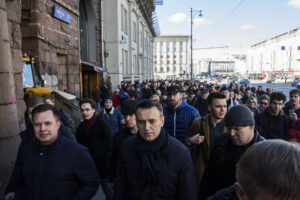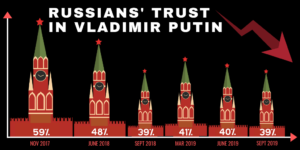Experts say the weekend protests in Russia, mainly in support of arrested opposition leader Alexei Navalny but also attracting members of the public angry at corruption and injustices in Russia, could be more significant than previous unrest, CNBC News reports.
By creating a model of guerrilla political warfare for the digital age, Navalny has exposed the regime’s utter lack of imagination and inability, observers suggest.
“It’s tempting here to take the Kremlin narrative that these (protests) were relatively small scale and are not backed by the wider population — hence will go nowhere,” said strategist Timothy Ash. “Indeed, there have been similar protests back in 2011, in 2015 following the murder of Boris Nemtsov, and in 2019 — which all went nowhere … But something feels different this time around“.
 The regime’s usual formula—stubborn indifference with doses of violence—may well work for Putin this time too, says Council on Foreign Relations analyst Stephen Sestanovich, a former National Endowment for Democracy (NED) board member. But novel elements of this bout of protests make the outcome less certain, he writes:
The regime’s usual formula—stubborn indifference with doses of violence—may well work for Putin this time too, says Council on Foreign Relations analyst Stephen Sestanovich, a former National Endowment for Democracy (NED) board member. But novel elements of this bout of protests make the outcome less certain, he writes:
- Alexei Navalny. With his bold decision to return to Moscow and the release of a widely viewed video purporting to expose regime corruption, Navalny has shown himself to be a capable and imaginative political figure—even from jail, perhaps the most formidable adversary Putin has faced.
- Navalny’s movement. Even if the crowds were not large in every case, the fact that protests occurred in more than one hundred cities shows that—for the first time—Putin faces a nationwide opposition. The strategic sophistication of Navalny’s team is underscored both by its video release and, before that, by its exposé of the Federal Security Services (FSB) personnel who poisoned him last summer.
- Electoral calendar. In 2020, Putin used his political supremacy to win a referendum that extended his legal tenure as president. This year, by contrast, brings parliamentary elections in which Putin will not be on the ballot…..
- Regime exhaustion. The final consideration is an imponderable but unavoidable issue: the seeming exhaustion of Putin’s regime…..His poll ratings are slipping; the economy has performed poorly for a decade; and his international standing is diminished. Putin’s obsession with the challenge posed by Navalny further conveys a lack of confidence.
https://t.co/vdKerAqGbL via @CFR_org
— Democracy Digest (@demdigest) January 25, 2021
Putin is in a Catch-22: If Putin kills Navalny, it could draw more attention to the problem and exacerbate unrest. If Putin lets Navalny live, then Navalny remains a focus for resistance, whether he is in prison or not, observers suggest.
“Navalny has very much outmaneuvered Putin at each turn since the poisoning. It’s becoming a bit humiliating for him, and I’m not sure how safe Navalny might be right now,” said a central European intelligence officer who works in Russia-related counterintelligence.
“Navalny was supposed to die last summer, and there would have been some protests, some arrests, maybe some sanctions,” the official said. While Putin survived the 2015 assassination of the dissident politician Boris Nemtsov “fine because Boris was dead and all that remained was outrage that eventually faded,” the official continued, “Navalny alive is a major problem.”

Alexei Navalny. Credit: Wikimedia
Navalny’s arrest, three days before Biden’s inauguration, which former U.S. ambassador to Russia Michael McFaul says has all the makings of “Biden’s first foreign policy crisis.”
“Whatever was in their transition documents, this is now front and center for them,” he told Axios.
Guerrilla political warfare for the digital age
By publicly identifying the members of the F.S.B. team involved in the assassination attempt against him, choosing to return to Russia even after the Kremlin signaled that he would be arrested on the spot, and releasing “Putin’s Palace” (above) after he was, Navalny has managed to force the Kremlin to play his game time and again, the New Yorker’s Joshua Yaffa adds. Navalny is creating a model of guerrilla political warfare for the digital age: the Russian state holds all the formal power and can tap virtually unlimited resources to stop the opposition leader, but he catches them flat-footed all the same.
 “He has shown the regime’s utter lack of imagination and inability to plan ahead,” as Masha Gessen put it.
“He has shown the regime’s utter lack of imagination and inability to plan ahead,” as Masha Gessen put it.
Whether the Russian leader’s carefully burnished image as the champion of ordinary citizens can survive such a process of mass repression is another question. As a keen student of the country’s history, Mr Putin will know that tsarist rule was shaken by repeated cycles of protest and repression before it was eventually toppled, notes FT analyst Gideon Rachman:
What happens next in Russia will be watched all over the world, particularly in China. Together, Mr Putin and President Xi Jinping have formed an axis of reaction — pushing back against pro-democracy movements around the world. The recent uprisings in Hong Kong and Belarus have seemed particularly threatening, because they took place so close to the power centres of Beijing and Moscow — and could serve to inspire Chinese or Russian opposition forces.
Navalny’s Long-Running Battle with Putin Enters a New Phase https://t.co/MTiQXdoljr via @NewYorker
— Democracy Digest (@demdigest) January 25, 2021







